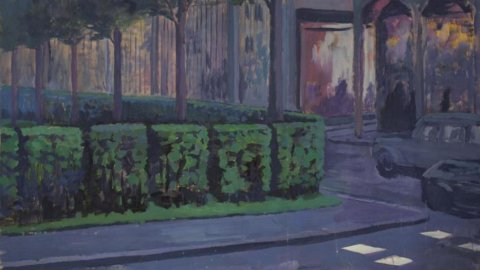The one that can be admired from 7 June to 23 November at Ca' Foscari will be the first Italian exhibition of Mikhail Roginsky, the so-called "father of Russian pop art".
The choice of Elena Rudenko, curator of the exhibition (Project Commissioner: Ekaterina Kondranina; Scientific Directors: Prof. Silvia Burini and Prof. Giuseppe Barbieri) is precise: to focus the exhibition on the artist's mature works (1978-2003) . The span of years that Mikhail Roginsky lived in Paris. This fundamental period of Roginsky's will thus be investigated extensively, with a focus on painting and on the structural concepts inherent in it: colour, form, construction.
The exhibition, and it is no coincidence, starts with a work prior to the Paris season. With that «Red Door» (1965) which belongs to the artist's Soviet period and which is certainly one of his most famous creations but also one of the most hermetic. The "door" is ideally the one that the artist climbs over, abandoning the cliché of a politicized artist, dedicated to complex conceptions, to arrive precisely at the new fields of painting.
Often considered by critics as a ready-made object, the "Door" instead heralds precisely his transition to painting: the artist himself underlined the close link of this work with easel painting.
With "The red door" Roginsky declares the will to overcome any conventionality of the dominant artistic language. In the post-war Soviet Union, the work represented one of the first attempts to deconstruct the two-dimensionality of the pictorial surface.
Here we find the premises of his manifest anti-aestheticism, the artist's aversion to the very word "art", understood by him as a complex of things created artificially, withered by age-old use or burdened by the weight of a hypocritical ideology.
The curators of the exhibition propose to leave the accumulation of erroneous definitions outside the door, to dismiss the stereotypes that have distorted the perception of the work, returning to its origins. The exhibition unfolds as a story of the artist's complex evolutionary process, for this reason the constitutive leitmotif is the journey as a metaphor for the creative journey.
It is a journey without a consequential scheme, designed to simplify the understanding of Roginsky's work. The artist is presented in all his creative breadth and the unity of the overall picture is not based on the chronological element but on the visual material of the exhibition.
From the space with the semi-abstract still lifes on the shelves, which go beyond figurativeness, the viewer moves towards a minimalist still life represented by simple "portraits" of simple objects, unshakable in their plastic certainty. From the room with the large acrylic works on paper, which simulate the imperturbability of «high» painting and ironically interpret its main genres, the viewer enters the altered, evocative world of the expressionist, who tries to give a shouted voice, through art, to the tormented process of loss of harmony. All along 8 sections in which the 120 works are presented together with a large number of photographic images and videos (many unpublished). To document a path that starts from the moment in which the artist resorts again to the abc of painting, searching for pure and mixed colors, the correlations between volumes, the compositional rhythm. To arrive at the final stage of his research and of his very existence. When the frequent returns to his homeland stimulate a new change in his painting. Soviet and post-Soviet Moscow acquires the same value as an artistic fact that Paris had for the Impressionists or deep America for Edward Hopper. Mikhail Roginsky's Moscow, a world inspired by his memory and imagination, pushes the viewer to the "recognizability" of concrete places, situations and characters. Stimulating the viewer to perceive the two-dimensional canvases as a consideration for reality.
Project submitted by:
Mikhail Roginsky Foundation
President of the Mikhail Roginsky Foundation - Inna Bazhenova
in collaboration with CSAR Center for Studies on the Arts of Russia, Ca' Foscari University, Venice
Project Commissioner: Ekaterina Kondranina
Scientific directors: Prof. Silvia Burini and Prof. Giuseppe Barbieri
Curator: Elena Rudenko
Architectural design: Eugene Asse / axis architects
General media partner: The Art Newspaper Russia
For information: www.unive.it





